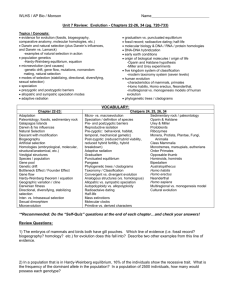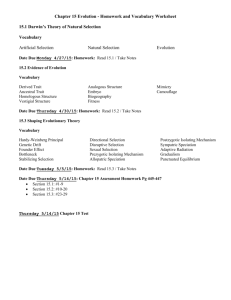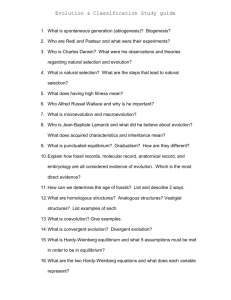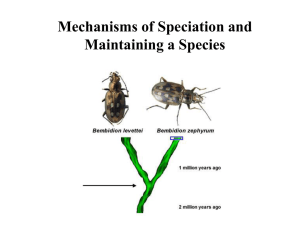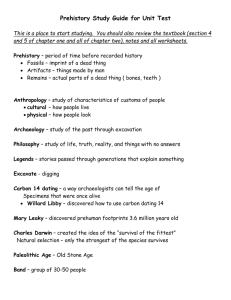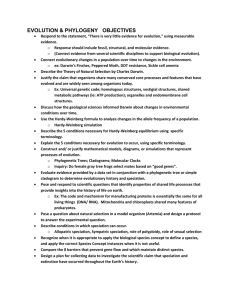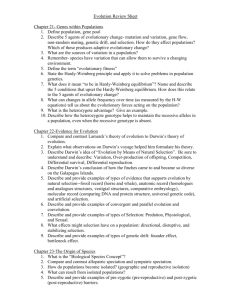Unit 7 Review: Evolution - Chapters 22-26, 34 (pg. 694-707)
advertisement
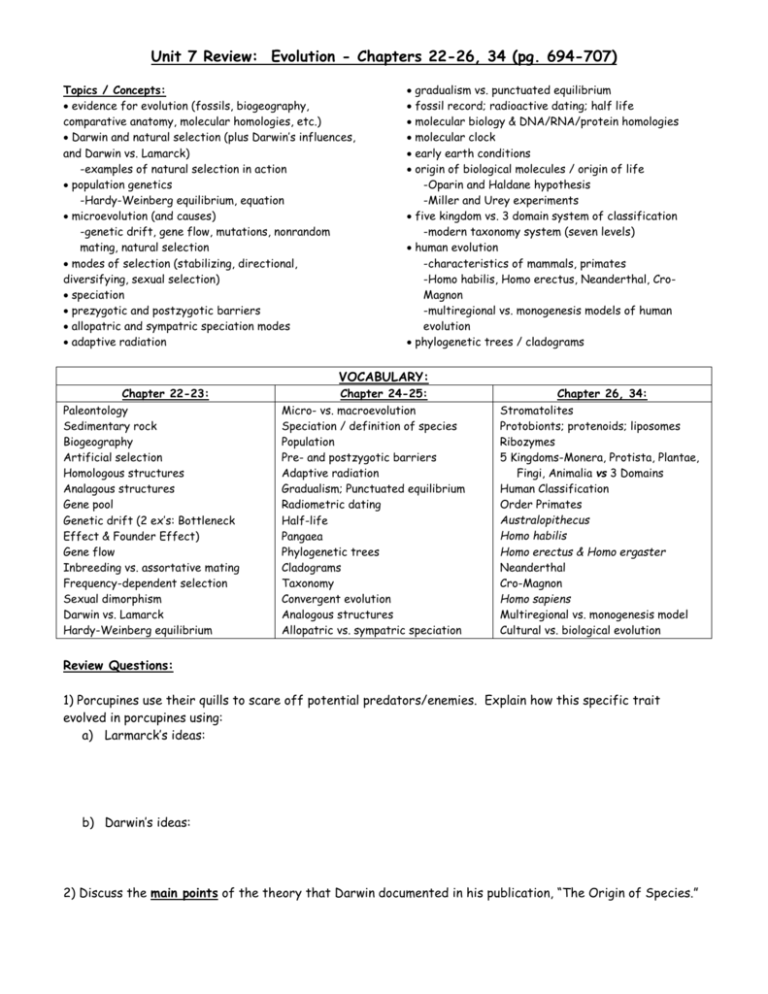
Unit 7 Review: Evolution - Chapters 22-26, 34 (pg. 694-707) Topics / Concepts: evidence for evolution (fossils, biogeography, comparative anatomy, molecular homologies, etc.) Darwin and natural selection (plus Darwin’s influences, and Darwin vs. Lamarck) -examples of natural selection in action population genetics -Hardy-Weinberg equilibrium, equation microevolution (and causes) -genetic drift, gene flow, mutations, nonrandom mating, natural selection modes of selection (stabilizing, directional, diversifying, sexual selection) speciation prezygotic and postzygotic barriers allopatric and sympatric speciation modes adaptive radiation gradualism vs. punctuated equilibrium fossil record; radioactive dating; half life molecular biology & DNA/RNA/protein homologies molecular clock early earth conditions origin of biological molecules / origin of life -Oparin and Haldane hypothesis -Miller and Urey experiments five kingdom vs. 3 domain system of classification -modern taxonomy system (seven levels) human evolution -characteristics of mammals, primates -Homo habilis, Homo erectus, Neanderthal, CroMagnon -multiregional vs. monogenesis models of human evolution phylogenetic trees / cladograms VOCABULARY: Chapter 22-23: Paleontology Sedimentary rock Biogeography Artificial selection Homologous structures Analagous structures Gene pool Genetic drift (2 ex’s: Bottleneck Effect & Founder Effect) Gene flow Inbreeding vs. assortative mating Frequency-dependent selection Sexual dimorphism Darwin vs. Lamarck Hardy-Weinberg equilibrium Chapter 24-25: Micro- vs. macroevolution Speciation / definition of species Population Pre- and postzygotic barriers Adaptive radiation Gradualism; Punctuated equilibrium Radiometric dating Half-life Pangaea Phylogenetic trees Cladograms Taxonomy Convergent evolution Analogous structures Allopatric vs. sympatric speciation Chapter 26, 34: Stromatolites Protobionts; protenoids; liposomes Ribozymes 5 Kingdoms-Monera, Protista, Plantae, Fingi, Animalia vs 3 Domains Human Classification Order Primates Australopithecus Homo habilis Homo erectus & Homo ergaster Neanderthal Cro-Magnon Homo sapiens Multiregional vs. monogenesis model Cultural vs. biological evolution Review Questions: 1) Porcupines use their quills to scare off potential predators/enemies. Explain how this specific trait evolved in porcupines using: a) Larmarck’s ideas: b) Darwin’s ideas: 2) Discuss the main points of the theory that Darwin documented in his publication, “The Origin of Species.” 3) The embryos of mammals and birds both have gill pouches. Which line of evidence for evolution does this fall into? Describe two other examples from this line of evidence. 4) In a population that is in Hardy-Weinberg equilibrium, 16% of the individuals show the recessive trait. What is the frequency of the dominant allele in the population? In a population of 2500 individuals, how many would possess each genotype? 5) In a population that is in Hardy-Weinberg equilibrium, the frequency of the dominant allele is 0.3. In a population of 15,550 individuals, how many would be heterozygous? 6) Distinguish between genetic drift and gene flow. 7) Why is it necessary to distinguish between homologies and analogies when creating phylogenetic trees? 8) List and describe at least 3 prezygotic and 3 postzygotic barriers that accomplish the isolation of gene pools of different populations. 9) Is evolution random or goal-oriented? (i.e. is there some ultimate goal or grand plan for evolution?) Explain. 10) Summarize the evolutionary trends seen in these hominid forms: Australopithecus africanus Homo erectus & H. ergaster Australopithecus afarensis Neanderthals Homo habilis Homo sapiens (when did certain changes appear…i.e. standing upright, larger brain, use of tools, cultural traditions, etc.) 11) Complete the chart below by listing the seven levels of taxonomic classification. For each category, use your textbook to look up and write in the appropriate classification for the following animals. Classification Group Humans Wolf Leopard Panther 12) Identify the type of reproductive barrier illustrated by the following examples and indicate whether they are pre- or postzygotic barriers. Type of Barrier Pre- or Postzygotic Example Two species of frogs are mated in the lab and produce viable, but sterile, offspring. Two species of sea urchin release their gametes at the same time, but cross-specific fertilization does not occur. Two species of orchid have different length nectar tubes and are pollinated by different species of moths. Two species of mayflies emerge during different weeks in springtime. Two species of salamanders will mate in the lab and produce viable, fertile offspring, but offspring of these hybrids are sterile. Two similar species of birds have different mating rituals. When two species of mice are bred in the lab, embryos usually abort. Peepers breed in woodland ponds, whereas leopard frogs breed in swamps. 13) Compare the gradualism and punctuated equilibrium theories/models of evolution. 14) A fossil has 1/8 the normal ratio of C-14 to C-12. Estimate the age of this fossil. (Carbon-14 has a halflife of approx. 5770 years) 15) Potassium-40 has a half-life of 1.3 billion years. If an organism had 1 mg of potassium-40 when it died and its fossil now has 0.25 mg, how old is this fossil? 16) What is the evolutionary significance of demonstrating that fly eyes result using a mouse eye gene? 17) Why do extensive adaptive radiations often follow mass extinctions? 18) a) What is meant by a molecular clock? b) How did scientists use a molecular clock to investigate the origin of HIV? 19 a) What are phylogenetic trees? b) How are they constructed? c) In Figure 25.11, what is the closest relative of the Leopard? How do you know? d) In Figure 25.9, what is the most distant relative of the striped skunk that is still in the Family Mustelidae? How do you know? 20) Describe the impacts of the formation of Pangaea on the environment and on biological diversity.
